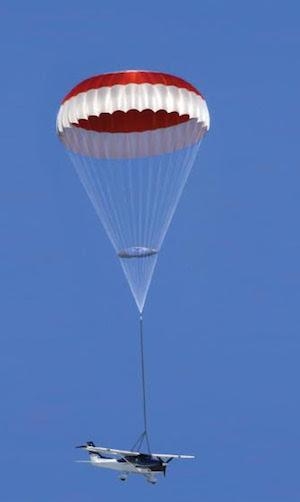Wed, Sep 26, 2018
Will Develop Supplemental Type Certificates For Existing And Planned Aircraft
BRS Aerospace has engaged Wichita State University's National Institute for Aviation Research (WSU-NIAR) to develop testing protocols for evaluating the safety and performance of aircraft parachute recovery systems in GA and VTOL aircraft.

Working with WSU-NIAR's Crash Dynamics and Virtual Engineering laboratories, BRS Aerospace will develop whole aircraft parachute recovery system Supplemental Type Certificates for a range of existing general aviation aircraft and approvals for new models currently under development in addition to advanced VTOL technology.
BRS is the world's leader in whole aircraft parachute recovery systems with more than 35,000 such systems installed on more than 350 models of airplanes. The company is also in the early stages of developing vehicle recovery systems technology that will allow VTOL aircraft to reach safety levels equivalent to standards established in the automotive industry.
"BRS Aerospace is very much looking forward to working with WSU-NIAR at the forefront of developing sophisticated technology and testing protocols which will bring our life-saving expertise to an expanded range of existing and new aircraft in addition to VTOL aircraft," said BRS Aerospace CEO Fernando de Caralt.
"One goal is to support safe autonomous flight over highly populated urban environments. It is a challenge that will require our expertise and the proven abilities of WSU-NIAR to develop thorough testing protocols," he said.
Already working with a number of new VTOL aircraft manufacturers, BRS Aerospace was represented at the UBER Elevate Summit 2018 as one of four critical gap technologies necessary for the successful development of the electric-powered VTOL ecosystem. Uber is promoting electric-powered VTOL urban transportation development.
"Our work with BRS Aerospace in expanding safety technology for a range of aircraft is a great example of public/private partnerships that can simultaneously benefit industry, improve safety and provide applied learning opportunities for students," said Dr. John Tomblin, WSU Vice President for Research and Technology Transfer.
"The partnership with BRS will be key to promoting the integrated safety approach developed at NIAR during the last thirteen years," said Crash Dynamics Laboratory Director Dr. Gerardo Olivares. "We look forward to working with BRS in our current facility and as the first industry collaboration at our new facility under construction at Wichita State."

BRS Aerospace already offers a parachute recovery system as a retrofit to Cessna 172/182 aircraft and as standard equipment on the popular Cirrus line of aircraft. BRS has delivered whole aircraft parachute systems to aviation segments including Light Sport Aircraft, experimental aircraft, ultralights, unmanned vehicles, military aircraft, and FAA/EASA Type Certified airplanes.
A recent independent statistical analysis concluded that when deployed, the ballistic recovery system significantly reduced the odds of experiencing a fatal aircraft accident. BRS has documented a total of 386 lives saved when the ballistic recovery system was deployed.
BRS Aerospace's whole aircraft parachute system for fixed-wing aircraft design calls for a parachute ballistic launcher to be installed in the aircraft with a pilot-initiated activator located in the cockpit. Upon activation, a ballistic rocket propels a parachute into the airstream to slow the airplane and float it down into a survivable vertical landing.
(Images provided with BSR Aerospace news release)
More News
From 2021: The Inside Skinny On What Being An ANN Oshkosh Stringer Is All About By ANN Senior Stringer Extraordinare, Gene Yarbrough The annual gathering at Oshkosh is a right of p>[...]
Video Showed That During The Takeoff, The Nose Baggage Door Was Open On May 10, 2025, about 0935 eastern daylight time, a Piper PA-32RT-300, N30689, was destroyed when it was invol>[...]
Get The Latest in Aviation News NOW on Instagram Are you on Instagram yet? It's been around for a few years, quietly picking up traction mostly thanks to everybody's new obsession >[...]
"I think what is key, we have offered a bonus to air traffic controllers who are eligible to retire. We are going to pay them a 20% bonus on their salary to stay longer. Don't reti>[...]
Aero Linx: Pilot Briefing The gathering, translation, interpretation, and summarization of weather and aeronautical information into a form usable by the pilot or flight supervisor>[...]
 Oshkosh Memories: An Aero-News Stringer Perspective
Oshkosh Memories: An Aero-News Stringer Perspective NTSB Prelim: Piper PA32RT
NTSB Prelim: Piper PA32RT ANN FAQ: Follow Us On Instagram!
ANN FAQ: Follow Us On Instagram! Aero-News: Quote of the Day (05.28.25)
Aero-News: Quote of the Day (05.28.25) ANN's Daily Aero-Term (05.28.25): Pilot Briefing
ANN's Daily Aero-Term (05.28.25): Pilot Briefing




